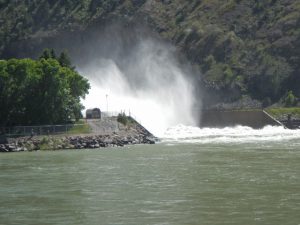Expect to have plenty of company if you visit the river from the Ora Bridge launch down to the Chester launch. BWO and midge life cycle and stonefly nymph patterns along with streamers under low light conditions are best bets for action. With more river to visit from Stone Bridge to Ashton, visiting anglers are more dispersed than in the river below Ashton Dam.
Here is Rob VanKirk’s latest summary of snow pack and water conditions in the Henry’s Fork drainage. Notice that snow pack conditions appear to be a bit below normal at the time of his report.
Headlines:
- Modest snowmelt continued yesterday at all elevations, despite cool temperatures.
- Natural streamflow continued its recession from last week’s small peak and was 84% of average yesterday.
- At a mean outflow of 418 cfs, Island Park Reservoir gained 22 ac-ft yesterday. Current content is 120,795 ac-ft (89% full), compared with an average of 115,907 ac-ft (86% full).
Details:
Yesterday was dry yet again, but at least temperatures were cooler. Mean temperature was 9 degrees F below average and the coolest since March 31. Water-year precipitation to date stayed at 81% of average. Despite cool temperatures, all but one SnoTel station lost snow water equivalent (SWE) yesterday. Island Park lost the most, at 0.5 inch of melt, and the watershed total was 0.2 inch. Melt rate has averaged 0.13 inch/day over the first 12 days of April so far. SWE is 78% of average and lower than it was on this date in 2016, the last very dry year experienced in the watershed.
Light precipitation—in the form of snow at all elevations—is expected tomorrow and Thursday. Forecast amounts range from around 0.1 inch in the northeastern corner of the watershed to 0.5 inch in the southern part of the Teton Range. Valley areas and the Teton subwatershed are expected to receive the highest amounts. Cool temperatures will stick around through the end of the week. Warm, dry conditions are expected after that.
Natural streamflow continued to drop yesterday, despite ongoing snowmelt. Natural flow was 84% of average yesterday: 81% in upper Henry’s Fork, 83% in Fall River, and 91% in Teton River. Diversion continues to increase slowly, although data are not yet being reported for all canals. Moisture availability in the agricultural areas—defined by my crude difference between precipitation and evapotranspiration—continues to drop and is now almost 7 inches below average. I have already had to extend the vertical axis on the chart twice since last summer and may need to do so again in a week or so.
At an average outflow of 418 cfs, Island Park Reservoir gained 22 ac-ft yesterday. Current content is 120,795 ac-ft (89% full), compared with an average of 115,907 ac-ft (86% full). Although ice is starting to melt at the edges at some locations around the reservoir, Fall River Electric personnel report solid ice cover around the dam.
Graphics:
Watershed SWE

Natural Stream Flow










